In 1858 the only buildings on Barry Island, in South Glamorgan, were a farmhouse and a summer residence built by Francis Crawshay, the industrialist son of William Crawshay, Ironmaster of Merthyr Tydfil. The huge sweep of sand on Whitmore Bay made it a perfect summer retreat and escape from the smut and smoke of the coal and steel industry of the valleys. This residence later became a refreshment room used by occasional summer visitors for picnics. The Island was linked to the mainland only at low tide by stepping stones crossing the Cadoxton river. In 1879 the owner, Lord Windsor, closed the Island to visitors, converting it into a rabbit warren. The nearby village of Barry had, at that time, only about 80 residents.
Coal was king in the valleys of South Wales in the 19th century and much of it was carried down to Cardiff Docks on barges and in trains for export. The port of Cardiff expanded rapidly and soon ran out of room so the docks at Barry were built in 1884. The sinking of the docks meant that Barry Island became permanently attached to the mainland by a causeway built to carry the railway line to the docks. This new accessibility meant that Barry Island became popular with visitors and was the beginning of Barry Island as a seaside resort for the wider population.
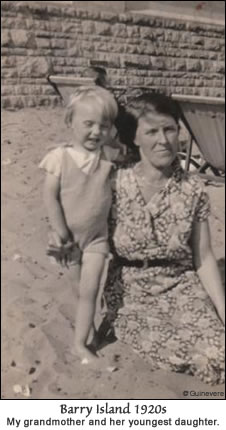
Barry began to grow rapidly as an industrial town and many people from the valleys went to Barry for work and the hope of a better life than they had in the valleys. Barry continued to expand and by 1921 had a population of just under 40,000. Among these were my grandparents and their four children who moved from Ebbw Vale to Barry after my grandfather went to work as a foreman in the foundry on the docks.
At weekends and on Bank Holidays the population of Barry Island was swollen by day trippers who came from the valleys on special excursion trains and in charabancs.
The churches and chapels for miles around brought children for Sunday School treats, paddle steamers from across the Bristol Channel brought more trippers – and Barry Island as a resort was born.
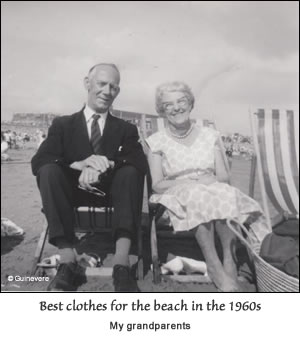
By the 1950s many locals were offering bed and breakfast during ‘Miners’ Fortnight’, with their own family all being crammed into one room to make room for the paying guests. My parents moved to Warwickshire after World War 2 and that’s where I was born, but every school holiday we would go to stay with my grandparents.
There was nothing remotely sophisticated about Barry Island when I first knew it. There were no Winter Gardens, no beach chalets lining the beach, no Grand Hotels and no refined tearooms. In the early days there was a ballroom, but by the 1950s it was a roller skating rink. This was the Barry Island I loved, cheap, cheerful, trashy and loud. I loved the fairground and the smell of hotdogs and candyfloss. I spent hours browsing the shops which sold buckets, spades and cheeky postcards. I begged my parents for coppers to spend in the many arcades which lined the road across from the beach.
The prom had 2 huge shelters where trippers would rush when the inevitable rain arrived. These had more arcades as well as shops selling fish and trips and ‘Trays for the Sand’. For a small deposit you could have a tray set with a huge teapot, a jug of milk and as many cups as you needed. The deckchair stacks were high and wide at 10 am but empty by noon. When the tide was up there was barely room for them all on the beach. Many trippers left them on the beach and my friends and I made a tidy income by taking them back for the deposit.
The sea wall was painted with numbers to help you remember where you were sitting, very necessary when the beach was crowded and the tide low. At the end of the prom was a ‘Lost Children’s Home’ where parents would find their tots who had wandered off. The Beach Inspector’s Office was the repository for last property. Every hour he used to patrol up and down the prom resplendent in his uniform, whatever the weather. His patrol took in the swimming pool at one end, a tidal pool built for children to play in in safety. Unfortunately the concrete sides and walkways were always slimy with algae, so it wasn’t that safe. In the middle of the prom was the Guinness Clock where people would wait for the hour to strike when all the animated figures would do their tricks.
When the tide was low there were colourful horse-drawn carts carrying passengers up and down to the water’s edge for a small fee. It was a real thrill when the driver urged the horse into the shallows and water splashed inside. There were pony rides for 6d on ponies with handles on their saddles, for safety. A pony ride was my ‘last treat’ before we headed for home.
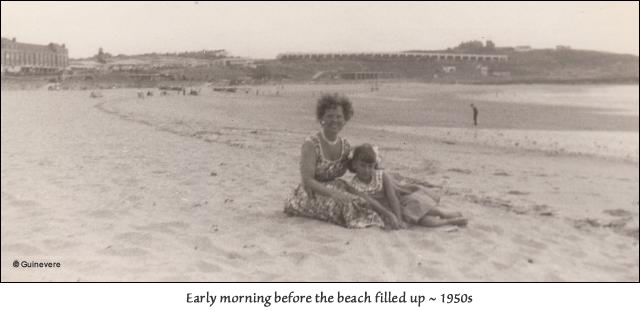
A local chapel used to hold beach services twice a day. They arrived early to rope off their area which annoyed late arrivals to the beach, left with nowhere to sit on dry sand. I think these stopped some time in the 1960s. There was great excitement when Lobby Ludd was in town. If you were carrying the right newspaper you could challenge him with, “You are Lobby Ludd and I claim my five pounds”. Other newspapers also had their own representatives.
In the 1960s Billy Butlin built a camp at Barry Island, making the beach even more crowded on sunny days, although some never left the camp. The high steel wire fence was patrolled by security guards to make sure no outsiders could get in. This became a challenge to the local lads who regularly scaled the wire to make use of the swimming pool and bars. The camp occupied the whole of Nell’s Point, once home to golf links and a wildlife haven. My grandparents took me there once to see the Royal Yacht Britannia sail by. The development was resisted by the locals, but Billy prevailed and took out a 99 year lease.
My family prefered a day on the pebble beach at Cold Knap in quieter surroundings, building a ‘cwtch’ in the pebbles to shelter from the wind, but this wasn’t for me. I loved the gaudiness of Barry Island.
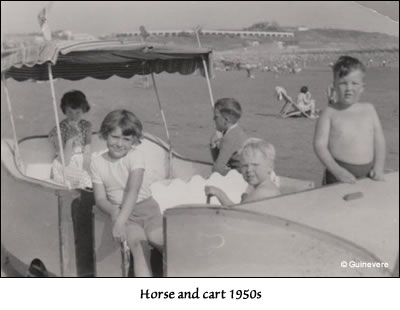 | 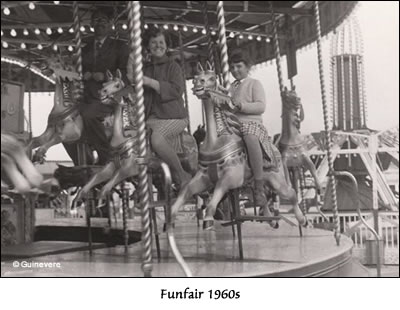 |
The glory years for Barry Island began in the 1890s but by the 1980s the resort was in decline. There was no room to expand the fairground or to build new attractions for changing tastes. Holidays abroad with guaranteed sun had become available for the average person at reasonable cost. Fewer people came on day trips, B&B holidays had lost their charm and families holidaying in Britain preferred holiday villages with caravans and clubs. There was nowhere on the Island to build these. Butlins closed in the 1980s and Barry Island became a shabby shadow of its former self.
In recent years the council has done its best to revive Barry Island’s fortunes. The prom has been repaved, gardens have been laid between the prom and the road and many businesses have been given a lick of paint. The arcades are still there and the shops selling beach goods. There are more pubs and fewer cafes, these rely on year round local trade, rather than holiday visitors. The sea, once the most polluted on the coast, has been cleaned up and there is a thriving marina at Jackson’s Bay. Barry Island is surviving, just.
Barry is very much part of my family history and the place I loved best as a child. My happiest times were spent there with my family in my grandparents’ home. I was born and brought up in the Midlands but Barry is still my ‘home’. It’s also a part of my husband’s family history as well. He was also born and brought up here in Warwickshire but his mother was born in Monmouthshire, where her father worked at Crumlin Mine Rescue Station. She trained to teach at Barry College, then found work in Hartshill where she met and married her husband. Family history is full of such coincidences but it was very spooky to discover that my future mother-in-law trained to teach at the same college as my aunt.
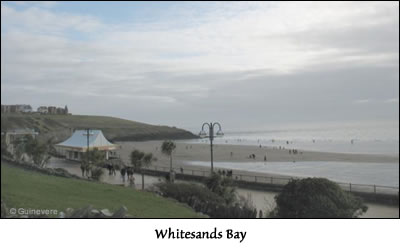 | 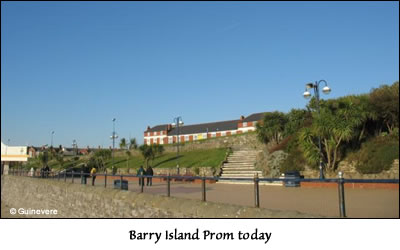 |
There is an even sadder connection. When mum in law was 10 and her brother 8 the family went to Barry Island for the day, for a treat.
From The Daily Herald, Friday 2nd August 1929:
Death On Barry Island Sands.
The death took place under particularly pathetic circumstances on Tuesday afternoon, when Mr Wallace Jeremiah Smith aged 36, Assistant Superintendent at The Crumlin Mines Rescue Station, dropped dead at the water’s edge in sight of his wife and two children who were playing on the sands.
His wife, playing with the children, rushed to his side and raised the alarm. St John Ambulance Brigade workers, with Police Constable John Harris, removed the body to the Ambulance Depot and applied artificial respiration without results.
In recent years, on Boxing Day, we have taken a day trip to Barry Island. The first visit was on impulse when I mentioned that I loved Boxing Day on the prom when I was a child. Here I learned to scoot my new scooter, ride my new two-wheeler bike and try out the roller skates that Santa had brought me. I still get that same feeling of elation as we drive up the causeway then stand on the prom looking out across the huge bay towards Somerset. Locals always know it will be a fine day when you can see the Somerset hills. We have breakfast in John’s Café and then walk the length of the beach and back along the prom, filled with children trying out their Christmas toys, just as I did, all those years ago.
Guinevere
© Guinevere 2009